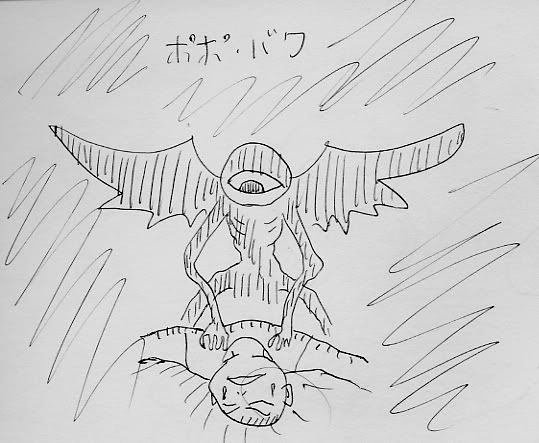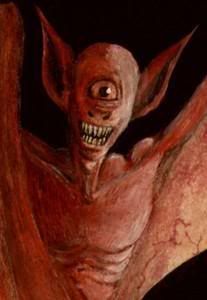In this edition of The Cryptid Files, we deal with a strange spirit of Zanzibar that roams the night, looking for houses to invade, and victims to sodomize! Read on..The Unfortunate Tale of Mjaka HamadA man from Zanzibar tearfully relates his ordeal to the media- Mjaka Hamad, a peasant farmer in his mid-50's, claims he's been brutally sodomized by the infamous
Popobawa. This particular attack in 1995 caused widespread panic among the local residents of these islands, just off the coast of Tanzania in Africa.
Was our farmer making it all up? Maybe a nightmare, even? According to Hamad, he knew it was not a dream because when he woke from his sleep, the household was in uproar.

According to
About.com's Paranormal Phenomena, this is what Hamad had to relate about his harrowing experience:
I couldn't see it. I could only feel it. But some people in my house could see it. Those who've got the spirits in their heads could see it. Everybody was terrified. They were outside screaming Huyo! It means the Popobawa is there. I had this bad pain in my ribs where it crushed me. I don't believe in spirits so maybe that's why it attacked me. Maybe it will attack anybody who doesn't believe.
Hamad was just one of the victims of the infamous Popobawa. Hospitals in Zanzibar have had dozens of cases attributed to Popobawa-inflicted injuries: mostly broken ribs and bruises.
According to X-Project Paranormal Magazine, during times when the Popobawa terrorizes the islands, whole families will often sleep arm-in-arm in front of their houses, seeking safety in numbers.
The PopobawaThe strange creature known as the Popobawa is generally described as a cyclopean dwarf- its one eye centrally located on its large forehead. Reports say the monster also has huge, leathery bat-like wings and ears, sharp claws, and a gigantic penis.

Even stranger is the Popobawa's propensity to anally rape men in their sleep- kind of like a homosexual incubus. The creature attacks its victims as they sleep, overpowering them, forcefully holding their face to the floor and ass-raping them for up to an hour.
And to literally add insult to injury, after it sodomizes its victim, the Popobawa commands the unfortunate male to spread the word of his ordeal, or it would come back for more.
Though often invisible, the creature can be detected by the sound of sharp claws scratching against the victims' rooftops, and an acrid smell or a puff of smoke. In some accounts, such as in the unfortunate case of Mjaka Hamad, the Popobawa is visible to everyone except the terrified victim.
Supposedly, the shapeshifting Popobawa takes human form by day, and blends in among the locals. Only its pointed fingers give a hint to its true identity.
Dealing With the PopobawaThe creature only attacks men, and does so only when its victim is sleeping in his bed. For that reason, many men end up sleeping outside- in streets, on porches- especially after recent waves of Popobawa attacks and sightings.
Those who aren't Muslim have even resorted to smearing pig grease on their skins to keep the demon from latching onto them.
Some have resorted to sacrificing goats, or offering charms by the base of fig trees to help exorcise the Popobawa. Others have even dug around their homes, burying pig bones, to ward off the creature.
What really ticks the monster off is ignoring it: denying the initial experience ever happened supposedly results in repeated, longer and more brutal sodomizations. It seems the hapless victims have no other choice but to tell all their friends and neighbors about the embarrassing incident.
Other Popobawa FactsThe name 'Popobawa' comes from the Swahili words for "bat" and "wing". Some suggest that the original name was 'Pepo Bawa', which means 'winged spirit'.
According to
Wikipedia, a popular origin story of Popobawa proposes that in the 1970s an angry sheikh released a djinni to take vengeance on his neighbors. The sheik lost control of the djinni, who took to demonic ways.
Interestingly enough, the Popobawa is a fairly recent cryptid. Reports say that the Popobawa first appeared in 1972, on a neighboring island called Pemba. Waves of sightings and incidents were then reported in the 1980's. And then another wave of attacks came in 1995 (the time of Mjaka Hamad's experience). Then again in 2000-2001, and most recently in Dar Es Salaam in 2007.
Increased Popobawa activity seems to coincide with elections, but its victims would claim that the rise and fall of the electoral cycle has nothing to do with the creature's attacks.
Normal Paranormal just brought you another edition of The Cryptid Files: Rediscovering our Strange World one Freak of Nature at a Time.
Cheers, everyone!
 The Mauritianum scientific museum in the town of Altenburg in Thurinia, Germany has a display of the largest well-known rat king (above; picture from Wikipedia). It was said to have been found in a miller's fireplace in 1828, and consists of some 32 rats joined together at the tail.
The Mauritianum scientific museum in the town of Altenburg in Thurinia, Germany has a display of the largest well-known rat king (above; picture from Wikipedia). It was said to have been found in a miller's fireplace in 1828, and consists of some 32 rats joined together at the tail. Theoretically, it is possible to have a rat king- assuming there are thousands of rats living in a tightly cramped space. Some of the young rodents just might find their tails inextricably tied together.
Theoretically, it is possible to have a rat king- assuming there are thousands of rats living in a tightly cramped space. Some of the young rodents just might find their tails inextricably tied together.










